MEMS-Based Oscillator Market Size
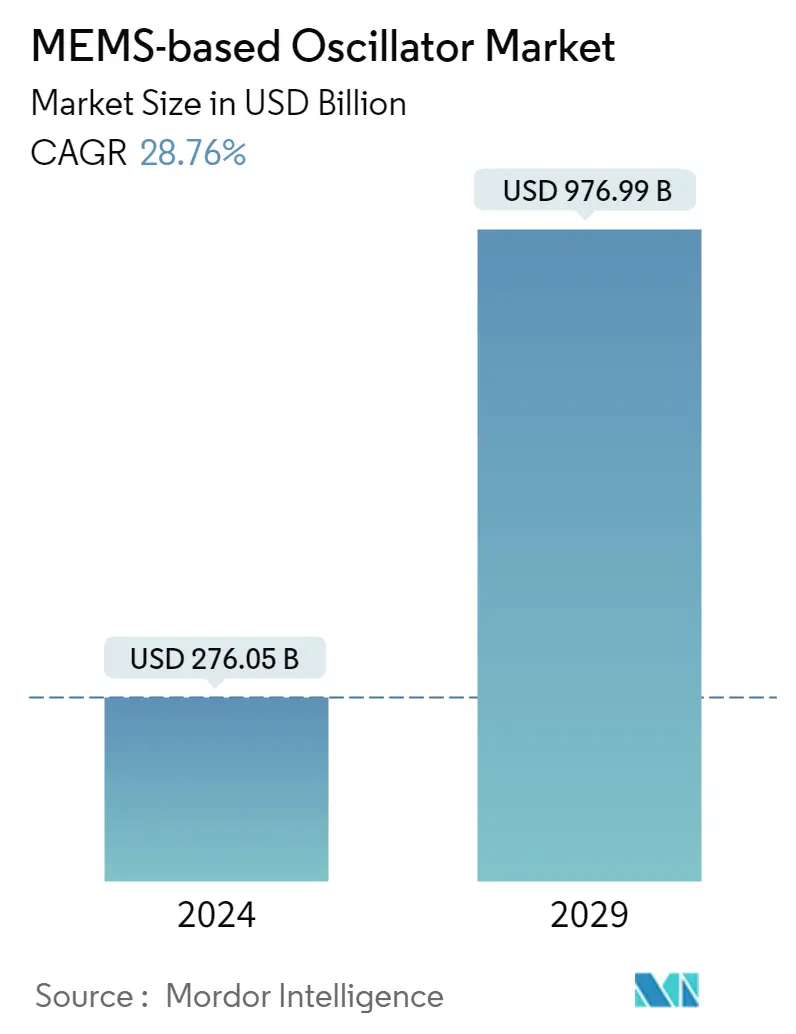
| Study Period | 2019 - 2029 |
| Market Size (2024) | USD 276.05 Billion |
| Market Size (2029) | USD 976.99 Billion |
| CAGR (2024 - 2029) | 28.76 % |
| Fastest Growing Market | Asia-Pacific |
| Largest Market | Asia-Pacific |
Major Players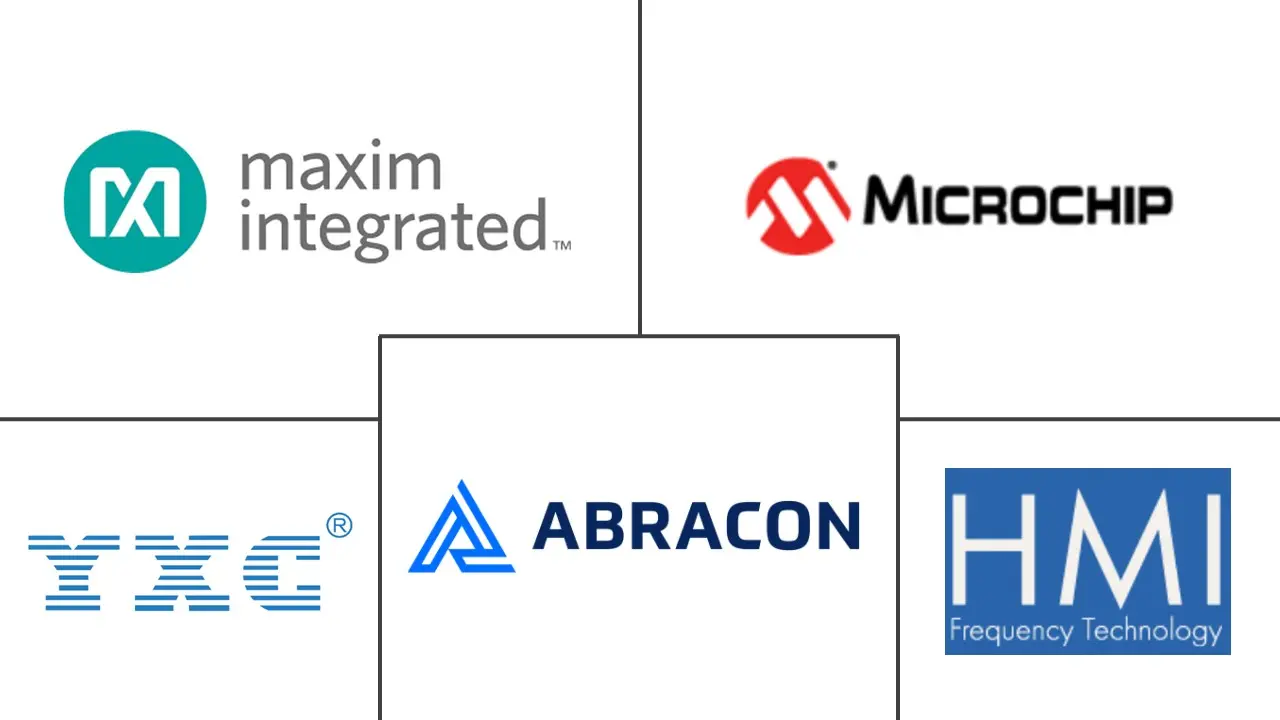
*Disclaimer: Major Players sorted in no particular order |
MEMS-Based Oscillator Market Analysis
The MEMS-based Oscillator Market size is estimated at USD 276.05 billion in 2024, and is expected to reach USD 976.99 billion by 2029, growing at a CAGR of 28.76% during the forecast period (2024-2029).
The MEMS oscillator market is accelerated due to increased demand for products from end-use industries worldwide.
- MEMS oscillators are a class of timing apparatus that help create extremely stable reference frequencies that can measure moments. In order to manage information exchange, assess the timing, describe radio frequencies, and place orders for electronic devices, these comparison frequencies are frequently used.
- MEMS and silicon-based technologies also operate over a broad frequency range, are less sensitive to frequency jumps, and are highly resistant to mechanical shock, vibration, and temperature changes. As a result, this technology has been helpful for developing small-sized timing solutions that are also robust, high-performing, and programmable.
- For instance, the silicon MEMS-based oscillator DSC1001 from Microchip offers a broad range of supply voltages and temperatures, including 1MHz to 150MHz with supply voltages between 1.8 and 3.3 VDC and temperature ranges up to -40C to 105C. The device offers jitter and stability performance as low as 10ppm.
- The high R&D costs involved in the development of MEMS oscillator is poised to limit the number of companies operating in the market, which may lead to fewer developments of MEMS oscillators. The established players in the market put significant R&D efforts into designing and developing next-generation silicon timing systems solutions.
- The COVID-19 outbreak had a significant impact on the production of frequency control devices, causing delays in the shipping of finished goods across the automotive, consumer electronics, and aerospace industries. Due to the closure of well-known semiconductor factories, the supply chain was severely harmed. However, as microfluidics and pressure are connected to COVID-19, including respiratory diagnostics and other research tools to study COVID-19 patient monitoring, MEMS-based oscillator devices for medical monitoring applications have benefited.
MEMS-Based Oscillator Market Trends
This section covers the major market trends shaping the MEMS-based Oscillator Market according to our research experts:
The Consumer Electronics Segment Holds Significant Market Share
- Oscillators are electronic circuits that develop an electrical signal of a particular frequency by utilizing the vibrating crystal's (piezoelectric material) mechanical resonance. MEMS oscillators are complete timing systems based on a programmable architecture. It further witnesses significant demand aided by improved functionality, enhanced performance, and electronic device miniaturization. An oscillator works on the regulations of oscillation, a periodic fluctuation between two things based on energy changes. Computers, smartwatches, mobile systems, and many other devices use MEMS oscillators.
- The rise in portable and wearable electronics drives the need to reduce the energy consumption and footprint of all electronic components, especially oscillators. Oscillators based on Micro-Electro-Mechanical Systems (MEMS) technology combine accurate frequency generation with low power consumption and are becoming increasingly popular in clock circuits.
- MEMS oscillators offer an appealing combination of low power consumption, small size, high performance, and physical robustness, making them ideal for numerous applications, specifically in portable and wearable electronics. Further, cell phones, computers, watches, radios, and many other devices depend on their success on an electronic oscillator that delivers the output with a precise frequency to develop timing pulses and synchronize events.
- Moreover, in May 2022, TAITIEN launched ultra-low current crystal oscillators, OZ-D and OY-D, with current consumption of only 1.4μA, featuring a low power consumption design, small size, and high precision, that can be widely used in wearable gadgets and the Internet of Things (IoT) devices.
- Innovations across MEMS timing technology significantly contribute to physical space and power savings in wearable applications while improving reliability. Cost in such cases presents significant challenges as the segment falls into the consumer category. Further, with the advent of 5G network rollouts, particularly in consumer markets, the demand for compacter, higher frequency enabled, less timing slop-based MEMS oscillators for consumer electronics is expected to grow.
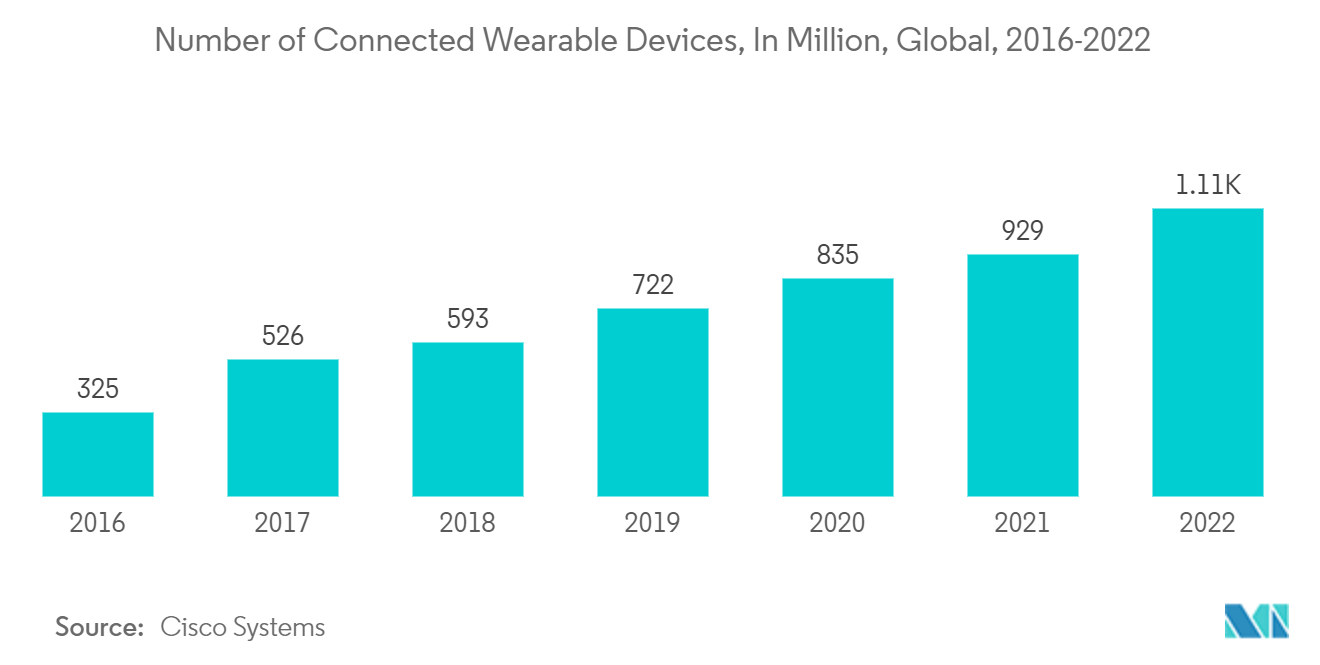
Asia-Pacific is Expected to be the Fastest Growing Market
- The Asia-Pacific is becoming a primary regional market, owing to the presence of countries such as China, Japan, India, and South Korea. The foundation of organizations based out of the region includes the rising demand for wearable technology such as fitness activities, smart watches, medical monitors/devices, etc. This factor indicates the considerable growth potential for the MEMS-based Oscillator Market in the Asia-Pacific region.
- In addition, intelligent wearables in the region are becoming fashionable as consumption upgrade is gaining momentum and tech-savvy consumers are willing to pay for such gadgets to embrace a more convenient and tech-driven life.
- The abundant availability of raw materials and the low establishment and labor costs have also helped companies launch their R&D and production centers in the region. For instance, Kyocera, a Kyoto, Japan-based electronics manufacturer, announced the construction of a new research and development center in January 2021 at its Kokubu campus in Kirishima City, Kagoshima, Japan.
- Players operating in the market have also adopted various growth strategies, such as acquisitions and integrations, new product offerings, collaborations, partnerships, and business expansions to accommodate the market's needs and expand their customer base.
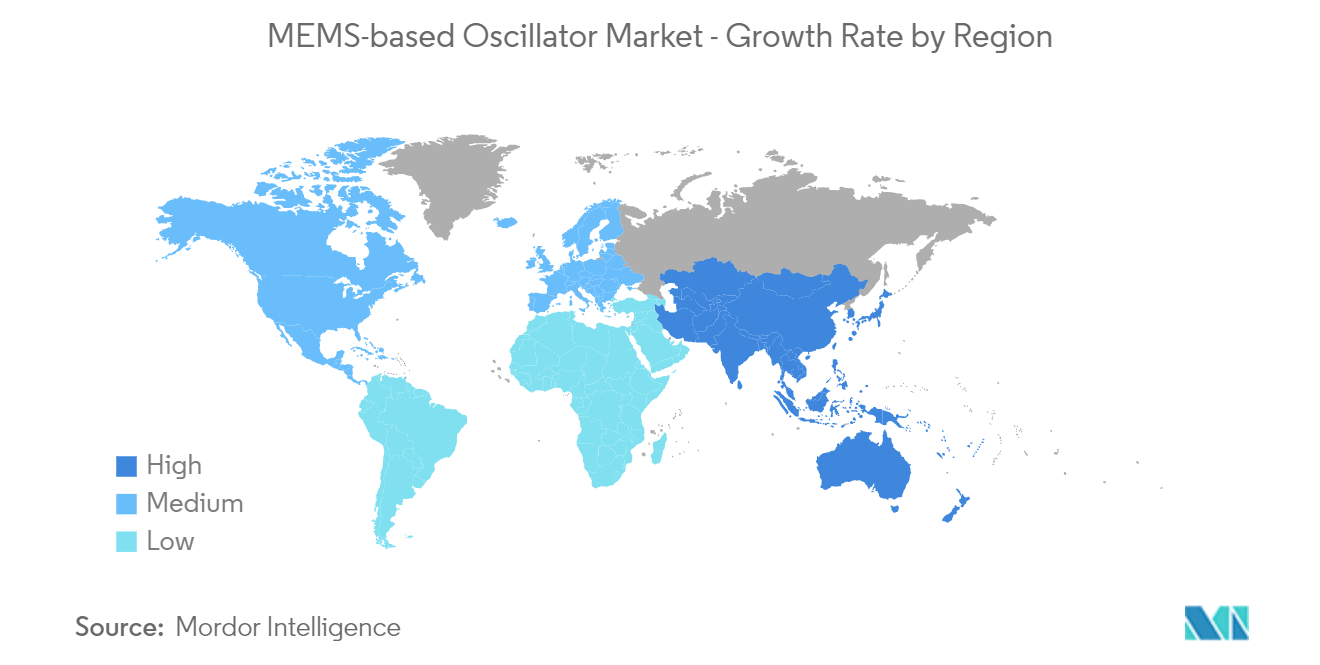
MEMS-Based Oscillator Industry Overview
The MEMS-based oscillator market has large-scale vendors capable of backward and forward integration and significant revenue generation capabilities. The market studied is highly consolidated, and vendors increasingly spend on R&D to gain technological capabilities and a competitive edge over other enterprises. The vendors are competing on technology and quality but not on price. Also, there is significant competition for third-party foundry and assembly capacity as most manufacturers depend on this capacity's availability to manufacture and assemble their products.
In September 2022: SiTime Corporation unveiled a unique automotive oscillator series based on the company's sophisticated MEMS technology. The redesigned differential oscillators are ten times more durable and assure ADAS reliability in harsh driving conditions and temperatures. The debut of the newest automotive oscillator, AEC-Q100 SiT9396/7, extends the SiTime serviced available market (SAM) by USD 50 million.
In July 2022: Abracon LLC (Abracon) announced that Genstar Capital had acquired it. Genstar is a private equity firm focused on investments in targeted segments of the industrials, financial services, healthcare, and software industries.
MEMS-Based Oscillator Market Leaders
-
Maxim Integrated Products Inc. (Analog Devices Inc.)
-
Microchip Technology Inc.
-
HMI Frequency Technology
-
Shenzhen Yangxing Technology Co. Ltd
-
Abracon LLC
*Disclaimer: Major Players sorted in no particular order
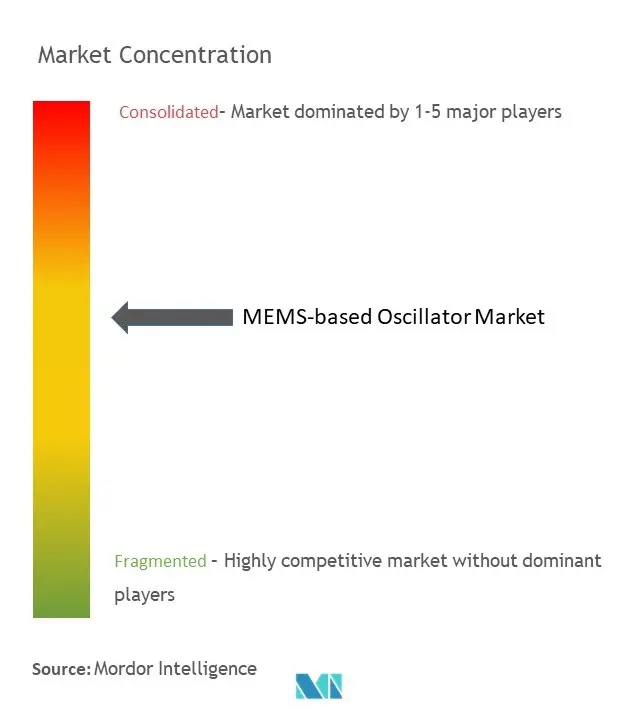
MEMS-Based Oscillator Market News
- November 2022: Rakon introduced equipment for Hi-Rel Space Master Reference Oscillators with 100ppb frequency stability for GEO telecommunication satellites, where accuracy, frequency stability, and extremely low phase noise are critical. The equipment is based on a 3:1 redundancy architecture, with output frequencies ranging from 5 to 200 MHz.
- November 2022: SiTime Corp. introduced the SiT5503 Elite XTM Super-TCXO, which improves timing efficiency in data centers and 5G infrastructure. The potential market for precise timing in communications enterprise is anticipated to reach USD 1.3 billion by 2024. The SiT5503 Elite X Super-TCXO will target the USD 200 million market by providing an unrivaled mix of capabilities and speed that enables quicker, more dependable networks.
- September 2022: Rakon Limited launched the RK409AVNS, a new Ultra Stable Oscillator (USO) with a high Allan Deviation (ADEV) of 2.5 x 10-13. The expanding need for Low Earth Orbit (LEO) PNT (Positioning, Navigation, and Timing) constellations alongside a crucial need for high-accurate frequency output signals is addressed by this device.
MEMS-Based Oscillator Market Report - Table of Contents
1. INTRODUCTION
- 1.1 Study Assumptions and Market Definition
- 1.2 Scope of the Study
2. RESEARCH METHODOLOGY
3. EXECUTIVE SUMMARY
4. MARKET INSIGHTS
- 4.1 Market Overview
-
4.2 Industry Attractiveness - Porter's Five Forces Analysis
- 4.2.1 Bargaining Power of Suppliers
- 4.2.2 Bargaining Power of Buyers
- 4.2.3 Threat of New Entrants
- 4.2.4 Threat of Substitute Products
- 4.2.5 Intensity of Competitive Rivalry
- 4.3 Industry Value Chain Analysis
- 4.4 Assessment of the Impact of COVID-19 on the Market
- 4.5 Key Considerations for Adopting MEMS Oscillators
5. MARKET DYANAMICS
-
5.1 Market Drivers
- 5.1.1 Advancement in Silicon-based Manufacturing and Packaging Techniques
-
5.2 Market Challenges
- 5.2.1 Complex Designs Leading to High R&D Costs
-
5.3 Market Opportunities
- 5.3.1 Emergence of 5G creating Demand for Better Timing Devices
6. MARKET SEGMENTATION
-
6.1 By Type
- 6.1.1 Temperature Compensated Oscillator (TCXO)
- 6.1.2 Spread Spectrum Oscillator (SSXO)
- 6.1.3 Voltage Control Oscillator (VCXO)
- 6.1.4 Digitally Controlled Oscillator (DCXO)
- 6.1.5 Other Types
-
6.2 By End-user Industry
- 6.2.1 Automotive
- 6.2.2 Aerospace and Defense
- 6.2.3 Consumer Electronics
- 6.2.4 IT and Telecom
- 6.2.5 Other End-user Industries
-
6.3 By Geography
- 6.3.1 North America
- 6.3.2 Europe
- 6.3.3 Asia-Pacific
- 6.3.4 Rest of the World
7. COMPETITIVE LANDSCAPE
-
7.1 Company Profiles
- 7.1.1 Maxim Integrated Products Inc. (Analog Devices Inc.)
- 7.1.2 Microchip Technology Inc.
- 7.1.3 HMI Frequency Technology
- 7.1.4 Shenzhen Yangxing Technology Co. Ltd
- 7.1.5 Abracon LLC
- 7.1.6 TXC Corporation
- 7.1.7 SiTime Corporation
- 7.1.8 Daishinku Corporation
- 7.1.9 Rakon Limited
- *List Not Exhaustive
8. INVESTMENT ANALYSIS
9. FUTURE OF THE MARKET
** Subject To AvailablityMEMS-Based Oscillator Industry Segmentation
MEMS-based oscillators are an integral part of every circuit implemented in the industry, and emit highly stable frequencies that can measure time. These reference frequencies may be used to sequence electronic systems, manage data transfer, define radio frequencies, and measure elapsed time. Quartz crystal-based oscillators have been the conventional choice for a wide range of applications in the industry. However, the emergence of MEMS-based silicon oscillators' commercial applications in the last decade has transformed the oscillator market.
The study includes market size estimations by considering the revenues accrued from the sales of MEMS-based oscillators as well as tracking the demand across several end-user industries, such as automotive, aerospace and defense, consumer electronics, IT, and telecom, in various geographies. All data presented in the study is as per the most recent information, and all market projections are adjusted to reflect the impact of COVID-19 on the MEMS-based oscillator market. The market sizes and forecasts are provided in terms of value (USD million) for all the segments.
| By Type | Temperature Compensated Oscillator (TCXO) |
| Spread Spectrum Oscillator (SSXO) | |
| Voltage Control Oscillator (VCXO) | |
| Digitally Controlled Oscillator (DCXO) | |
| Other Types | |
| By End-user Industry | Automotive |
| Aerospace and Defense | |
| Consumer Electronics | |
| IT and Telecom | |
| Other End-user Industries | |
| By Geography | North America |
| Europe | |
| Asia-Pacific | |
| Rest of the World |
MEMS-Based Oscillator Market Research FAQs
How big is the MEMS-based Oscillator Market?
The MEMS-based Oscillator Market size is expected to reach USD 276.05 billion in 2024 and grow at a CAGR of 28.76% to reach USD 976.99 billion by 2029.
What is the current MEMS-based Oscillator Market size?
In 2024, the MEMS-based Oscillator Market size is expected to reach USD 276.05 billion.
Who are the key players in MEMS-based Oscillator Market?
Maxim Integrated Products Inc. (Analog Devices Inc.), Microchip Technology Inc., HMI Frequency Technology , Shenzhen Yangxing Technology Co. Ltd and Abracon LLC are the major companies operating in the MEMS-based Oscillator Market.
Which is the fastest growing region in MEMS-based Oscillator Market?
Asia-Pacific is estimated to grow at the highest CAGR over the forecast period (2024-2029).
Which region has the biggest share in MEMS-based Oscillator Market?
In 2024, the Asia-Pacific accounts for the largest market share in MEMS-based Oscillator Market.
What years does this MEMS-based Oscillator Market cover, and what was the market size in 2023?
In 2023, the MEMS-based Oscillator Market size was estimated at USD 214.39 billion. The report covers the MEMS-based Oscillator Market historical market size for years: 2019, 2020, 2021, 2022 and 2023. The report also forecasts the MEMS-based Oscillator Market size for years: 2024, 2025, 2026, 2027, 2028 and 2029.
MEMS-Based Oscillator Industry Report
Statistics for the 2024 MEMS-Based Oscillator market share, size and revenue growth rate, created by Mordor Intelligence™ Industry Reports. MEMS-Based Oscillator analysis includes a market forecast outlook to 2029 and historical overview. Get a sample of this industry analysis as a free report PDF download.



